Evaluation of Machine Learning and Traditional Methods for Estimating Compressive Strength of UHPC
Abstract
1. Introduction
2. Methodology
2.1. Analyzing Dataset and Statistics
2.2. RSM Modeling
2.3. ANN Modeling
3. Results and Discussion
3.1. ANN Model
3.2. RSM Model
3.3. Sensitivity Analysis (SA)
3.4. Validation and Comparison of RSM and ANN Models
4. Discussion
5. Conclusions
- The empirical data-based ANN and RSM models have demonstrated their potential and utility in accurately simulating the compressive strength of ultra-high-performance concrete (UHPC).
- ANN has proven effective in predicting multiple preceding results simultaneously, unlike RSM, which needed to divide preceding results into groups to improve prediction accuracy.
- The ANN model outperforms RSM, with a strong correlation coefficient (R2) near 1 (0.91).
- The RSM model predicted compressive strength with R2 values of 0.90 and higher. The model was significant (p < 0.05) and without prediction bias.
- ANN and RSM predicted maximum compressive strengths of 219.7 MPa and 229.3 MPa at late ages and minimum compressive strengths of 31.2 MPa and 15.8 MPa at early ages, respectively.
- Sensitivity analysis of the ANN model reveals that the primary factor influencing compressive strength is coarse aggregate, accounting for 14.93% of the influence. Quartz powder accounts for 14.3% of the influence on the compressive strength estimate as a significant variable.
- However, the compressive strength of UHPC with ANN increases more with coarse aggregate, quartz powder, sand, cement, and limestone, whereas steel fiber and cement type decrease it.
Supplementary Materials
Author Contributions
Funding
Data Availability Statement
Conflicts of Interest
References
- Meng, Q.; Wu, C.; Li, J.; Liu, Z.; Wu, P.; Yang, Y.; Wang, Z. Steel/basalt rebar reinforced Ultra-High Performance Concrete components against methane-air explosion loads. Compos. Part B Eng. 2020, 198, 108215. [Google Scholar] [CrossRef]
- Li, P.; Sluijsmans, M.; Brouwers, H.; Yu, Q. Functionally graded ultra-high performance cementitious composite with enhanced impact properties. Compos. Part B Eng. 2020, 183, 107680. [Google Scholar] [CrossRef]
- Azmee, N.M.; Shafiq, N. Ultra-high performance concrete: From fundamental to applications. Case Stud. Constr. Mater. 2018, 9, e00197. [Google Scholar] [CrossRef]
- Ren, L.; Fang, Z.; Wang, K. Design and behavior of super-long span cable-stayed bridge with CFRP cables and UHPC members. Compos. Part B Eng. 2018, 164, 72–81. [Google Scholar] [CrossRef]
- Graybeal, B.; Brühwiler, E.; Kim, B.-S.; Toutlemonde, F.; Voo, Y.L.; Zaghi, A. International Perspective on UHPC in Bridge Engineering. J. Bridg. Eng. 2020, 25, 04020094. [Google Scholar] [CrossRef]
- Mahmud, G.H.; Hassan, A.M.; Jones, S.W.; Schleyer, G.K. Experimental and numerical studies of ultra high performance fibre reinforced concrete (UHPFRC) two-way slabs. Structures 2021, 29, 1763–1778. [Google Scholar] [CrossRef]
- Liu, J.; Wei, J.; Li, J.; Su, Y.; Wu, C. A comprehensive review of ultra-high performance concrete (UHPC) behaviour under blast loads. Cem. Concr. Compos. 2023, 148, 105449. [Google Scholar] [CrossRef]
- Zhang, X.; Wu, Z.; Xie, J.; Hu, X.; Shi, C. Trends toward lower-carbon ultra-high performance concrete (UHPC)—A review. Constr. Build. Mater. 2024, 420, 135602. [Google Scholar] [CrossRef]
- Dong, Z.; Wu, G.; Zhu, H.; Zhao, X.-L.; Wei, Y.; Qian, H. Flexural behavior of seawater sea-sand coral concrete–UHPC composite beams reinforced with BFRP bars. Constr. Build. Mater. 2020, 265, 120279. [Google Scholar] [CrossRef]
- Heniegal, A. Design of Self Compacting Concrete Using Artificial Neural. Mansoura Eng. J. 2020, 37, 50–73. [Google Scholar] [CrossRef]
- Khan, A.Q.; Awan, H.A.; Rasul, M.; Siddiqi, Z.A.; Pimanmas, A. Optimized artificial neural network model for accurate prediction of compressive strength of normal and high strength concrete. Clean. Mater. 2023, 10, 100211. [Google Scholar] [CrossRef]
- Alyouef, R.; Algaifi, H.A.; Alaskar, A. Engineering Properties of Waste Sawdust-Based Assessment and Numerical Prediction. Materials 2020, 13, 5490. [Google Scholar]
- Sadowski, Ł.; Piechówka-Mielnik, M.; Widziszowski, T.; Gardynik, A.; Mackiewicz, S. Hybrid ultrasonic-neural prediction of the compressive strength of environmentally friendly concrete screeds with high volume of waste quartz mineral dust. J. Clean. Prod. 2019, 212, 727–740. [Google Scholar] [CrossRef]
- Shamsabadi, E.A.; Roshan, N.; Hadigheh, S.A.; Nehdi, M.L.; Khodabakhshian, A.; Ghalehnovi, M. Machine learning-based compressive strength modelling of concrete incorporating waste marble powder. Constr. Build. Mater. 2021, 324, 126592. [Google Scholar] [CrossRef]
- Shahmansouri, A.A.; Yazdani, M.; Ghanbari, S.; Bengar, H.A.; Jafari, A.; Ghatte, H.F. Artificial neural network model to predict the compressive strength of eco-friendly geopolymer concrete incorporating silica fume and natural zeolite. J. Clean. Prod. 2021, 279, 123697. [Google Scholar] [CrossRef]
- Ali, M.; Kumar, A.; Yvaz, A.; Salah, B. Central composite design application in the optimization of the effect of pumice stone on lightweight concrete properties using RSM. Case Stud. Constr. Mater. 2023, 18, e01958. [Google Scholar] [CrossRef]
- Rantung, D.; Supit, S.W.; Nicolaas, S. Effects of different size of fly ash as cement replacement on self-compacting concrete properties. J. Sustain. Eng. Proc. Ser. 2019, 1, 180–186. [Google Scholar] [CrossRef][Green Version]
- Shah, S.A.R.; Ben Kahla, N.; Atig, M.; Anwar, M.K.; Azab, M.; Mahmood, A. Optimization of fresh and mechanical properties of sustainable concrete composite containing ARGF and fly ash: An application of response surface methodology. Constr. Build. Mater. 2023, 362, 129722. [Google Scholar] [CrossRef]
- Schober, P.; Boer, C.; Schwarte, L.A. Correlation Coefficients: Appropriate Use and Interpretation. Anesth. Analg. 2018, 126, 1763–1768. [Google Scholar] [CrossRef]
- Liu, Q.-F.; Iqbal, M.F.; Yang, J.; Lu, X.-Y.; Zhang, P.; Rauf, M. Prediction of chloride diffusivity in concrete using artificial neural network: Modelling and performance evaluation. Constr. Build. Mater. 2021, 268, 121082. [Google Scholar] [CrossRef]
- Jagadesh, P.; de Prado-Gil, J.; Silva-Monteiro, N.; Martínez-García, R. Assessing the compressive strength of self-compacting concrete with recycled aggregates from mix ratio using machine learning approach. J. Mater. Res. Technol. 2023, 24, 1483–1498. [Google Scholar] [CrossRef]
- Boudali, S.; Abdulsalam, B.; Rafiean, A.H.; Poncet, S.; Soliman, A.; ElSafty, A. Influence of Fine Recycled Concrete Powder on the Compressive Strength of Self-Compacting Concrete (SCC) Using Artificial Neural Network. Sustainability 2021, 13, 3111. [Google Scholar] [CrossRef]
- Chen, H.; Li, X.; Wu, Y.; Zuo, L.; Lu, M.; Zhou, Y. Compressive Strength Prediction of High-Strength Concrete Using Long Short-Term Memory and Machine Learning Algorithms. Buildings 2022, 12, 302. [Google Scholar] [CrossRef]
- Adamu, M.; Mohammed, B.S.; Liew, M.S. Mechanical properties and performance of high volume fly ash roller compacted concrete containing crumb rubber and nano silica. Constr. Build. Mater. 2018, 171, 521–538. [Google Scholar] [CrossRef]
- Aldahdooh, M.; Bunnori, N.M.; Johari, M.M. Evaluation of ultra-high-performance-fiber reinforced concrete binder content using the response surface method. Mater. Des. 2013, 52, 957–965. [Google Scholar] [CrossRef]
- Essam, A.; Mostafa, S.A.; Khan, M.; Tahwia, A.M. Modified particle packing approach for optimizing waste marble powder as a cement substitute in high-performance concrete. Constr. Build. Mater. 2023, 409, 133845. [Google Scholar] [CrossRef]
- Ferdosian, I.; Camões, A. Eco-efficient ultra-high performance concrete development by means of response surface methodology. Cem. Concr. Compos. 2017, 84, 146–156. [Google Scholar] [CrossRef]
- Behnood, A.; Golafshani, E.M. Predicting the compressive strength of silica fume concrete using hybrid artificial neural network with multi-objective grey wolves. J. Clean. Prod. 2018, 202, 54–64. [Google Scholar] [CrossRef]
- Ofuyatan, O.M.; Agbawhe, O.B.; Omole, D.O.; Igwegbe, C.A.; Ighalo, J.O. RSM and ANN modelling of the mechanical properties of self-compacting concrete with silica fume and plastic waste as partial constituent replacement. Clean. Mater. 2022, 4, 100065. [Google Scholar] [CrossRef]
- Ghosh, A.; Das, P.; Sinha, K. Modeling of biosorption of Cu(II) by alkali-modified spent tea leaves using response surface methodology (RSM) and artificial neural network (ANN). Appl. Water Sci. 2015, 5, 191–199. [Google Scholar] [CrossRef]
- Iqbal, M.A.; Ali, M.; Bahu, M.A.; Nadeem, K.Z.; Mustafa, M.A.; Raza, A. Application of Artificial Neural Networks for Predicting Axial Strain of FRP-Confined Concrete. MATEC Web Conf. 2024, 398, 01033. [Google Scholar] [CrossRef]
- Jaf, D.K.I.; Abdalla, A.; Mohammed, A.S.; Abdulrahman, P.I.; Kurda, R. Hybrid nonlinear regression model versus MARS, MEP, and ANN to evaluate the effect of the size and content of waste tire rubber on the compressive strength of concrete. Heliyon 2024, 10, e25997. [Google Scholar] [CrossRef]
- Kursuncu, B.; Gencel, O.; Bayraktar, O.Y.; Shi, J.; Nematzadeh, M.; Kaplan, G. Optimization of foam concrete characteristics using response surface methodology and artificial neural networks. Constr. Build. Mater. 2022, 337, 127575. [Google Scholar] [CrossRef]
- Rahman, S.K.; Al-Ameri, R. Structural assessment of Basalt FRP reinforced self-compacting geopolymer concrete using artificial neural network (ANN) modelling. Constr. Build. Mater. 2023, 397, 132464. [Google Scholar] [CrossRef]
- Abbas, B.A.; Adisa, S.N.; Abubakar, J.; Akorede, B.A.; Alabi, A.S. An ann model for predicting slump of concrete containing crushed glass and natural gravel. Usak Univ. J. Eng. Sci. 2024, 7, 43–53. [Google Scholar] [CrossRef]
- Van Dao, D.; Ly, H.-B.; Vu, H.-L.T.; Le, T.-T.; Pham, B.T. Investigation and Optimization of the C-ANN Structure in Predicting the Compressive Strength of Foamed Concrete. Materials 2020, 13, 1072. [Google Scholar] [CrossRef]
- Zermane, H.; Madjour, H.; Ziar, A.; Zermane, A. Forecasting material quantity using machine learning and times series techniques. J. Electr. Eng. 2024, 75, 237–248. [Google Scholar] [CrossRef]
- Ardiansyah, M.F.R.; Wijaya, R.; Wulandari, G.S. Comparative Prediction of Physical Fatigue Patterns in Bandung, Indonesia Workers using CNN and ANN. J. Media Inform. Budidarma 2024, 8, 537. [Google Scholar] [CrossRef]
- Luo, X.; Xing, G.; Qiao, L.; Miao, P.; Yu, X.; Ma, K. Multi-objective optimization of the mix proportion for dune sand concrete based on response surface methodology. Constr. Build. Mater. 2023, 366, 129928. [Google Scholar] [CrossRef]
- Adamu, M.; Marouf, M.L.; Ibrahim, Y.E.; Ahmed, O.S.; Alanazi, H.; Marouf, A.L. Modeling and optimization of the mechanical properties of date fiber reinforced concrete containing silica fume using response surface methodology. Case Stud. Constr. Mater. 2022, 17, e01633. [Google Scholar] [CrossRef]
- Adamu, M.; Trabanpruek, P.; Jongvivatsakul, P.; Likitlersuang, S.; Iwanami, M. Mechanical performance and optimization of high-volume fly ash concrete containing plastic wastes and graphene nanoplatelets using response surface methodology. Constr. Build. Mater. 2021, 308, 125085. [Google Scholar] [CrossRef]
- Bheel, N.; Waqar, A.; Radu, D.; Benjeddou, O.; Alwetaishi, M.; Almujibah, H.R. A comprehensive study on the impact of nano-silica and ground granulated blast furnace slag on high strength concrete characteristics: RSM modeling and optimization. Structures 2024, 62, 106160. [Google Scholar] [CrossRef]
- He, H.; Cheng, S.; Chen, Y.; Lan, B. Compression performance analysis of multi-scale modified concrete based on response surface method. Case Stud. Constr. Mater. 2022, 17, e01312. [Google Scholar] [CrossRef]
- Chindasiriphan, P.; Meenyut, B.; Orasutthikul, S.; Jongvivatsakul, P.; Tangchirapat, W. Influences of high-volume coal bottom ash as cement and fine aggregate replacements on strength and heat evolution of eco-friendly high-strength concrete. J. Build. Eng. 2023, 65, 105791. [Google Scholar] [CrossRef]
- Ayanlere, S.; Ajamu, S.; Odeyemi, S.; Ajayi, O.; Kareem, M. Effects of water-cement ratio on bond strength of concrete. Mater. Today Proc. 2023, 86, 134–139. [Google Scholar] [CrossRef]
- Anjali, R.; Venkatesan, G. Optimization and prediction of mechanical properties of composite concrete with crumb rubber using RSM and hybrid DNN-HHO algorithm. J. Build. Eng. 2024, 84, 108486. [Google Scholar] [CrossRef]
- Aghajanzadeh, I.; Ramezanianpour, A.M.; Amani, A.; Habibi, A. Mixture optimization of alkali activated slag concrete containing recycled concrete aggregates and silica fume using response surface method. Constr. Build. Mater. 2024, 425, 135928. [Google Scholar] [CrossRef]
- Patil, S.; Bhaskar, R.; Xavier, J.R.; Raja, R. Experimental evaluation and statistical modeling of sustainable sisal fiber-reinforced fly ash-based lateritic concrete using response surface methodology. J. Build. Eng. 2024, 84, 108498. [Google Scholar] [CrossRef]
- Ma, H.; Sun, Z.; Ma, G. Research on Compressive Strength of Manufactured Sand Concrete Based on Response Surface Methodology (RSM). Appl. Sci. 2022, 12, 3506. [Google Scholar] [CrossRef]
- De-Prado-Gil, J.; Martínez-García, R.; Jagadesh, P.; Juan-Valdés, A.; Gónzalez-Alonso, M.-I.; Palencia, C. To determine the compressive strength of self-compacting recycled aggregate concrete using artificial neural network (ANN). Ain Shams Eng. J. 2023, 15, 102548. [Google Scholar] [CrossRef]
- De-Prado-Gil, J.; Zaid, O.; Palencia, C.; Martínez-García, R. Prediction of Splitting Tensile Strength of Self-Compacting Recycled Aggregate Concrete Using Novel Deep Learning Methods. Mathematics 2022, 10, 2245. [Google Scholar] [CrossRef]
- Mai, H.-V.T.; Nguyen, M.H.; Ly, H.-B. Development of machine learning methods to predict the compressive strength of fiber-reinforced self-compacting concrete and sensitivity analysis. Constr. Build. Mater. 2023, 367, 130339. [Google Scholar] [CrossRef]
- Dahmoune, F.; Remini, H.; Dairi, S.; Aoun, O.; Moussi, K.; Bouaoudia-Madi, N.; Adjeroud, N.; Kadri, N.; Lefsih, K.; Boughani, L.; et al. Ultrasound assisted extraction of phenolic compounds from P. lentiscus L. leaves: Comparative study of artificial neural network (ANN) versus degree of experiment for prediction ability of phenolic compounds recovery. Ind. Crop. Prod. 2015, 77, 251–261. [Google Scholar] [CrossRef]
- Khan, K.; Johari, M.A.M.; Amin, M.N.; Khan, M.I.; Iqbal, M. Optimization of colloidal nano-silica based cementitious mortar composites using RSM and ANN approaches. Results Eng. 2023, 20, 101390. [Google Scholar] [CrossRef]
- Rizalman, A.N.; Lee, C.C. Comparison of Artificial Neural Network (ANN) and Response Surface Methodology (RSM) in Predicting the Compressive Strength of POFA Concrete. Appl. Model. Simul. 2021, 4, 210–216. [Google Scholar]
- Hammoudi, A.; Moussaceb, K.; Belebchouche, C.; Dahmoune, F. Comparison of artificial neural network (ANN) and response surface methodology (RSM) prediction in compressive strength of recycled concrete aggregates. Constr. Build. Mater. 2019, 209, 425–436. [Google Scholar] [CrossRef]
- Al-Kahtani, M.S.M.; Zhu, H.; Ibrahim, Y.E.; Haruna, S.I.; Al-Qahtani, S.S.M. Study on the Mechanical Properties of Polyurethane-Cement Mortar Containing Nanosilica: RSM and Machine Learning Approach. Appl. Sci. 2023, 13, 13348. [Google Scholar] [CrossRef]
- Kumar, S.; Kumar, D.R.; Wipulanusat, W.; Keawsawasvong, S. Development of ANN-based metaheuristic models for the study of the durability characteristics of high-volume fly ash self-compacting concrete with silica fume. J. Build. Eng. 2024, 94, 109844. [Google Scholar] [CrossRef]
- Mater, Y.; Kamel, M.; Karam, A.; Bakhoum, E. ANN-Python prediction model for the compressive strength of green concrete. Constr. Innov. 2022, 23, 340–359. [Google Scholar] [CrossRef]
- Afzali, S.A.E.; Shayanfar, M.A.; Ghanooni-Bagha, M.; Golafshani, E.; Ngo, T. The use of machine learning techniques to investigate the properties of metakaolin-based geopolymer concrete. J. Clean. Prod. 2024, 446, 141305. [Google Scholar] [CrossRef]
- Hoang, N.-D.; Pham, A.-D.; Nguyen, Q.-L.; Pham, Q.-N. Estimating Compressive Strength of High Performance Concrete with Gaussian Process Regression Model. Adv. Civ. Eng. 2016, 2016, 1–8. [Google Scholar] [CrossRef]
- Song, H.; Ahmad, A.; Ostrowski, K.A.; Dudek, M. Analyzing the Compressive Strength of Ceramic Waste-Based Concrete Using Experiment and Artificial Neural Network (ANN) Approach. Materials 2021, 14, 4518. [Google Scholar] [CrossRef] [PubMed]
- Jahangir, H.; Eidgahee, D.R. A new and robust hybrid artificial bee colony algorithm—ANN model for FRP-concrete bond strength evaluation. Compos. Struct. 2021, 257, 113160. [Google Scholar] [CrossRef]
- Ali, M.; Khan, M.I.; Masood, F.; Alsulami, B.T.; Bouallegue, B.; Nawaz, R.; Fediuk, R. Central composite design application in the optimization of the effect of waste foundry sand on concrete properties using RSM. Structures 2022, 46, 1581–1594. [Google Scholar] [CrossRef]
- Ho, C.; Doh, S.; Chin, S.; Li, X. Prediction of concrete residual compressive strength under elevated temperatures: Response surface methodology (RSM) approach. Mater. Today Proc. 2023. [Google Scholar] [CrossRef]
- Parhi, S.K.; Patro, S.K. Application of R-curve, ANCOVA, and RSM techniques on fracture toughness enhancement in PET fiber-reinforced concrete. Constr. Build. Mater. 2024, 411, 134644. [Google Scholar] [CrossRef]
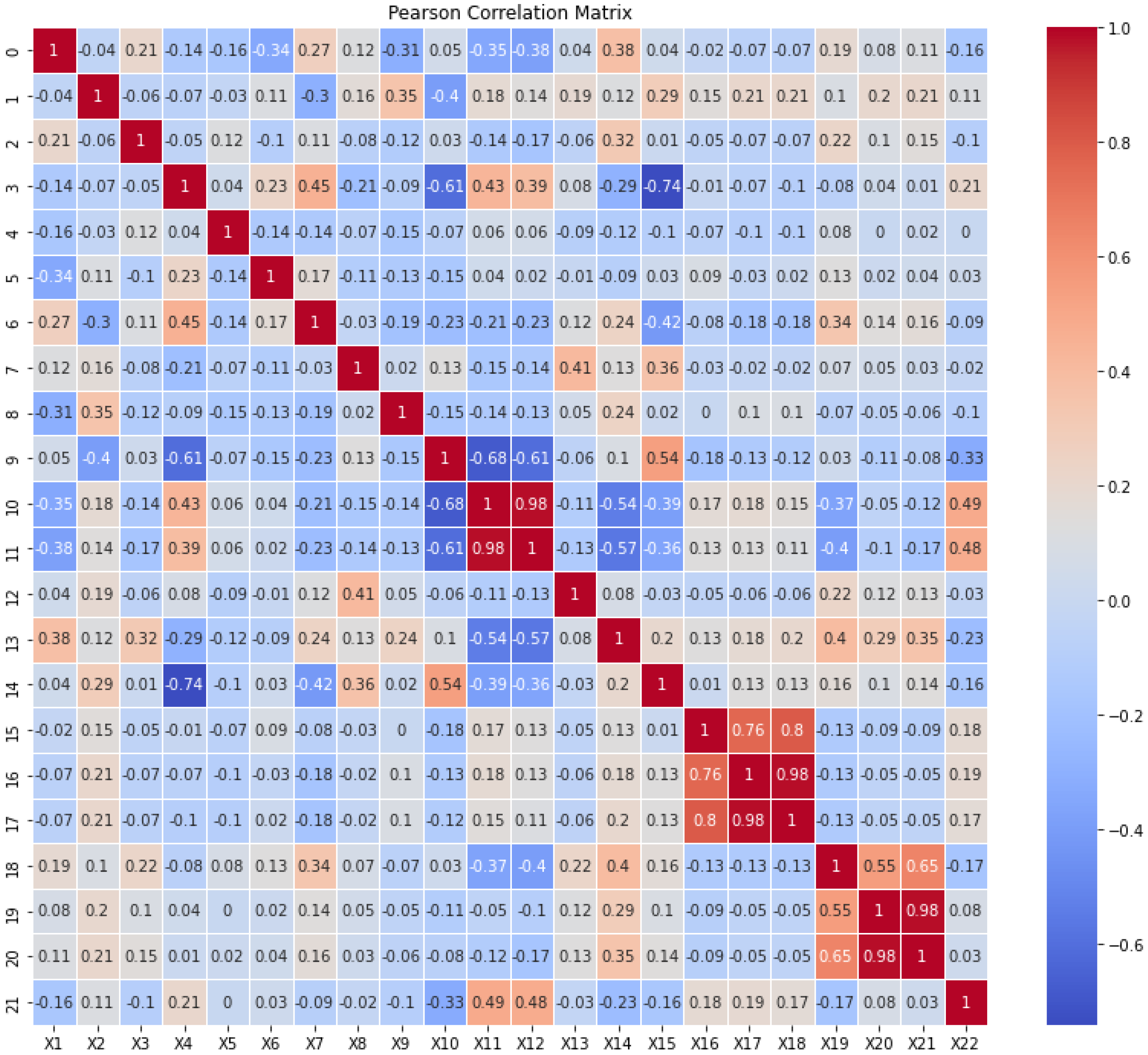
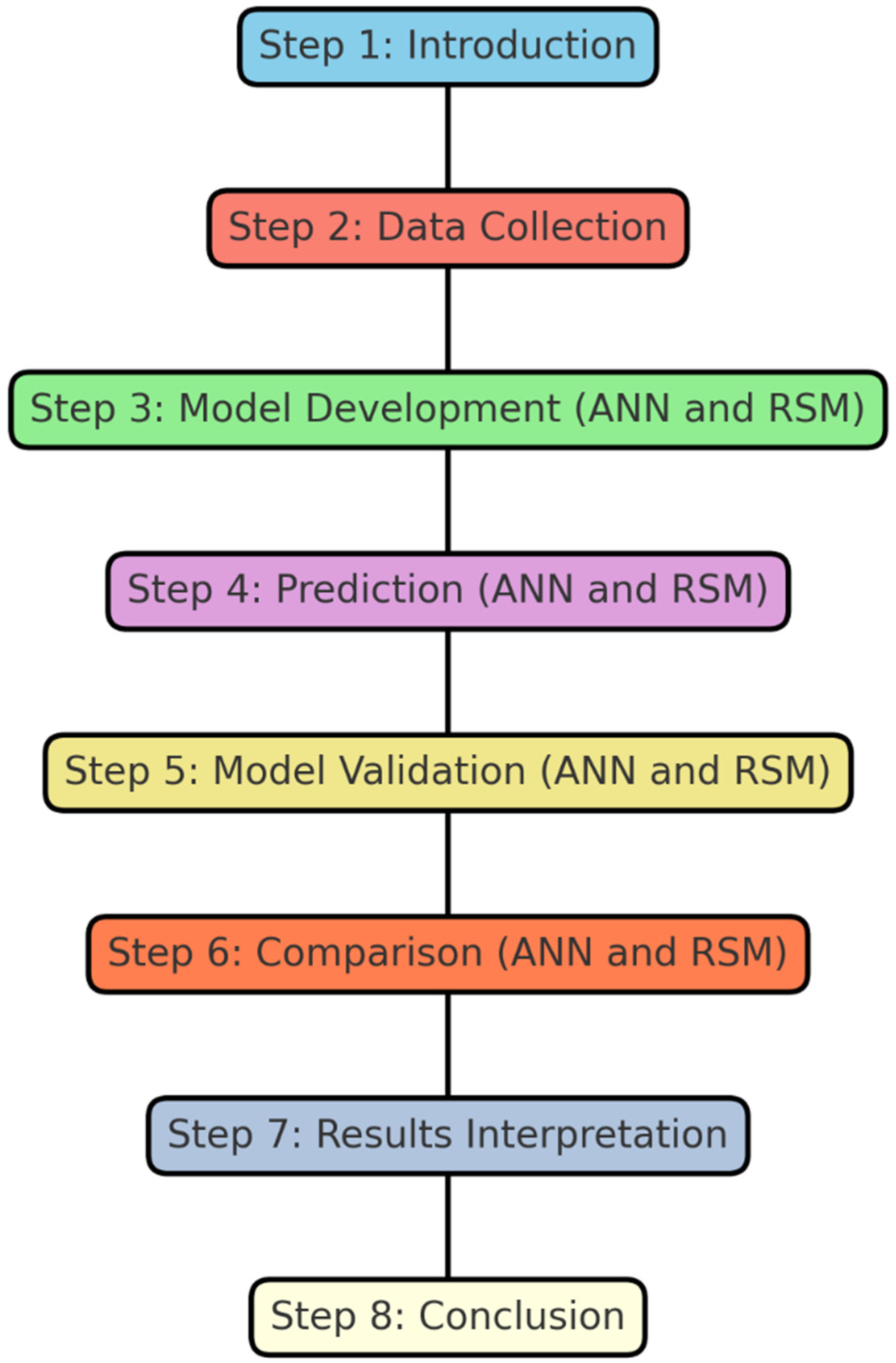
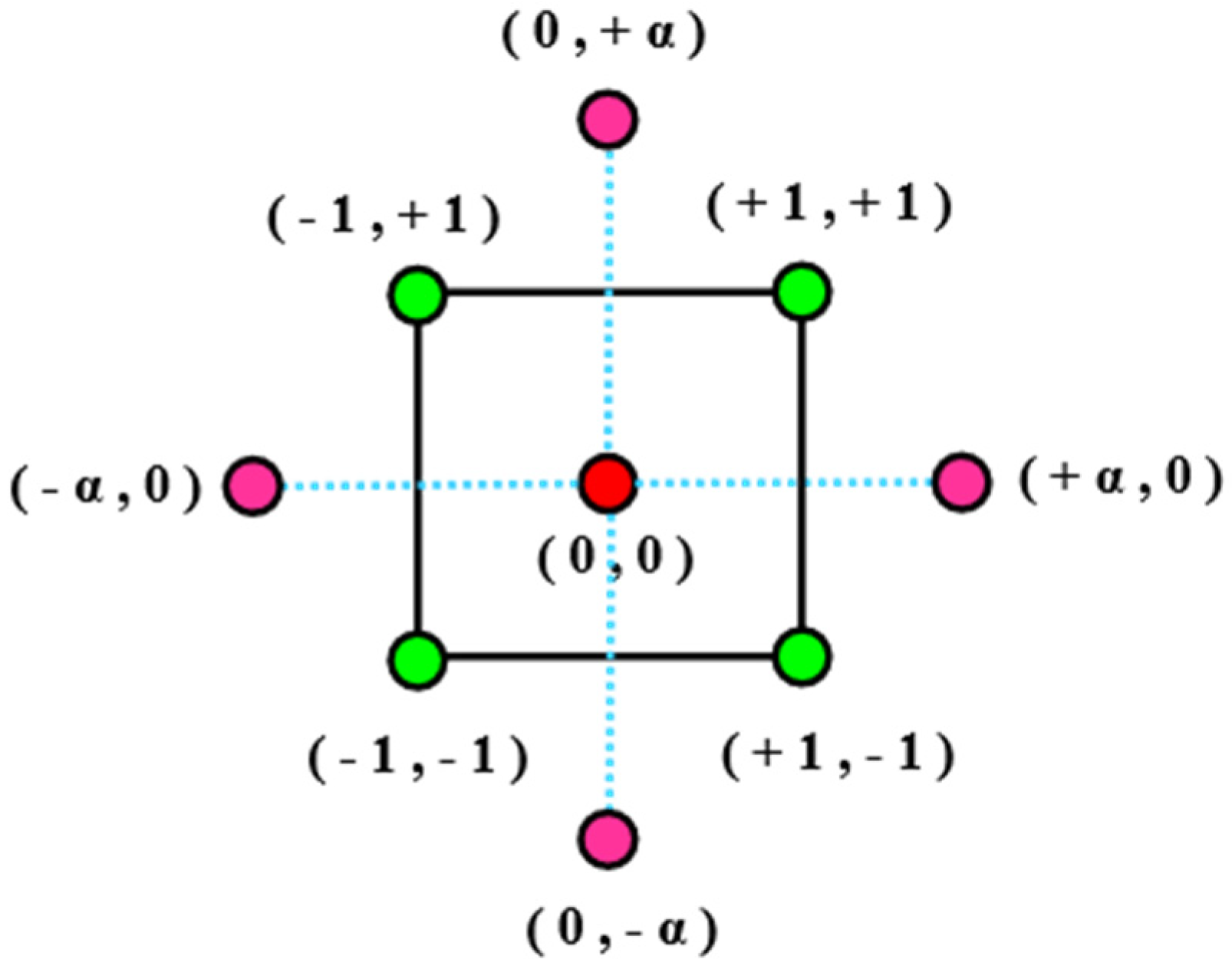

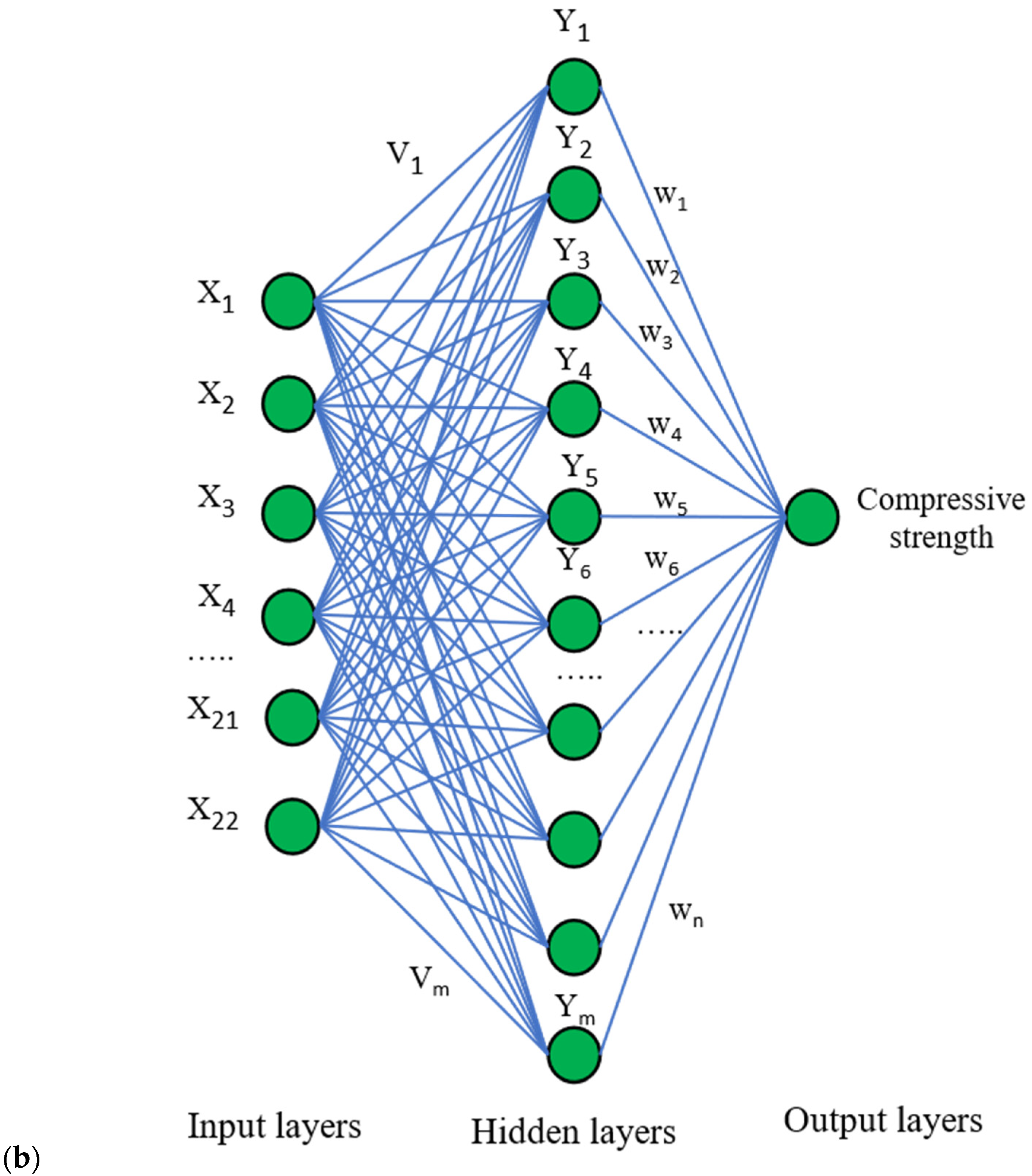
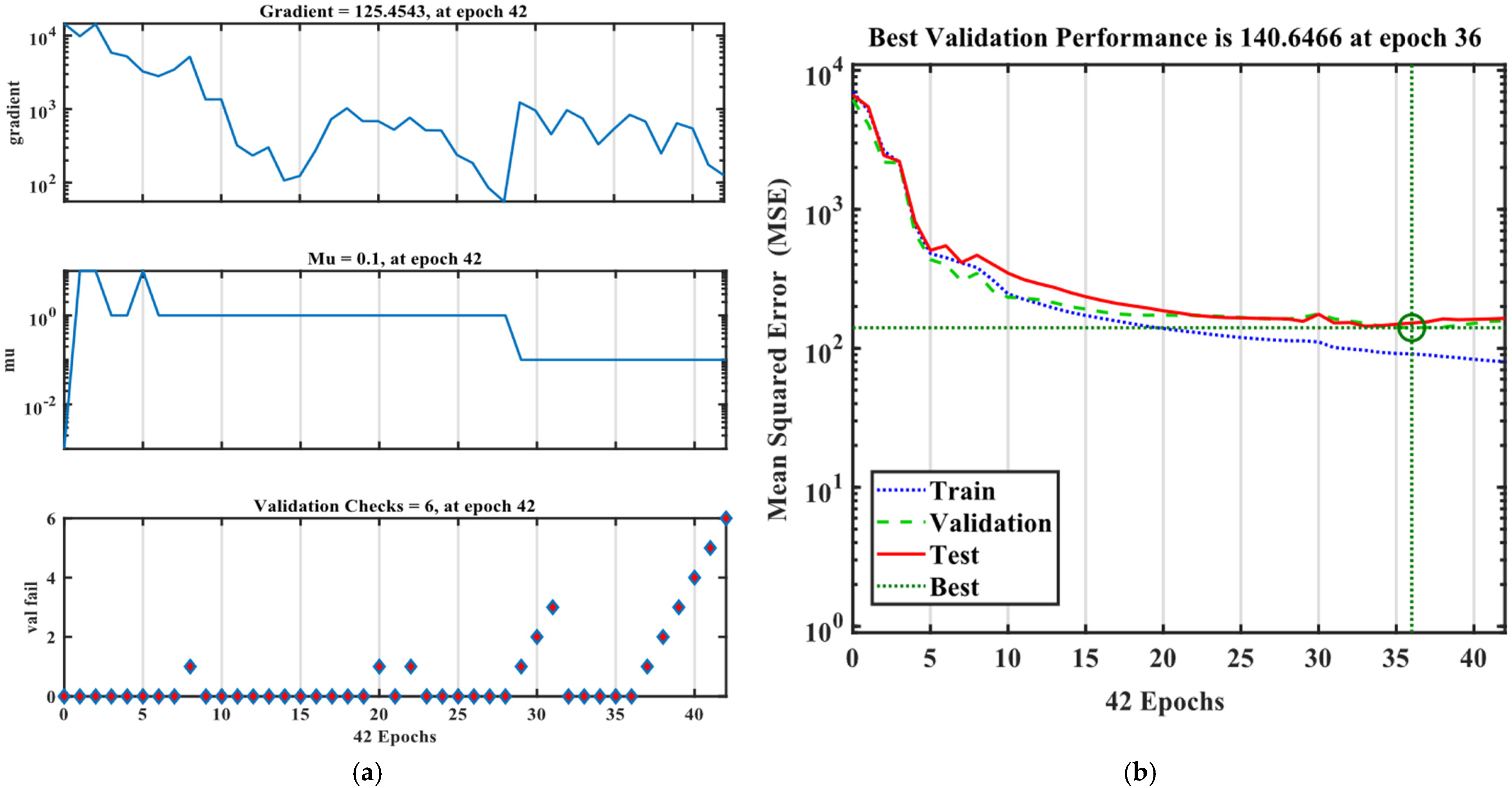
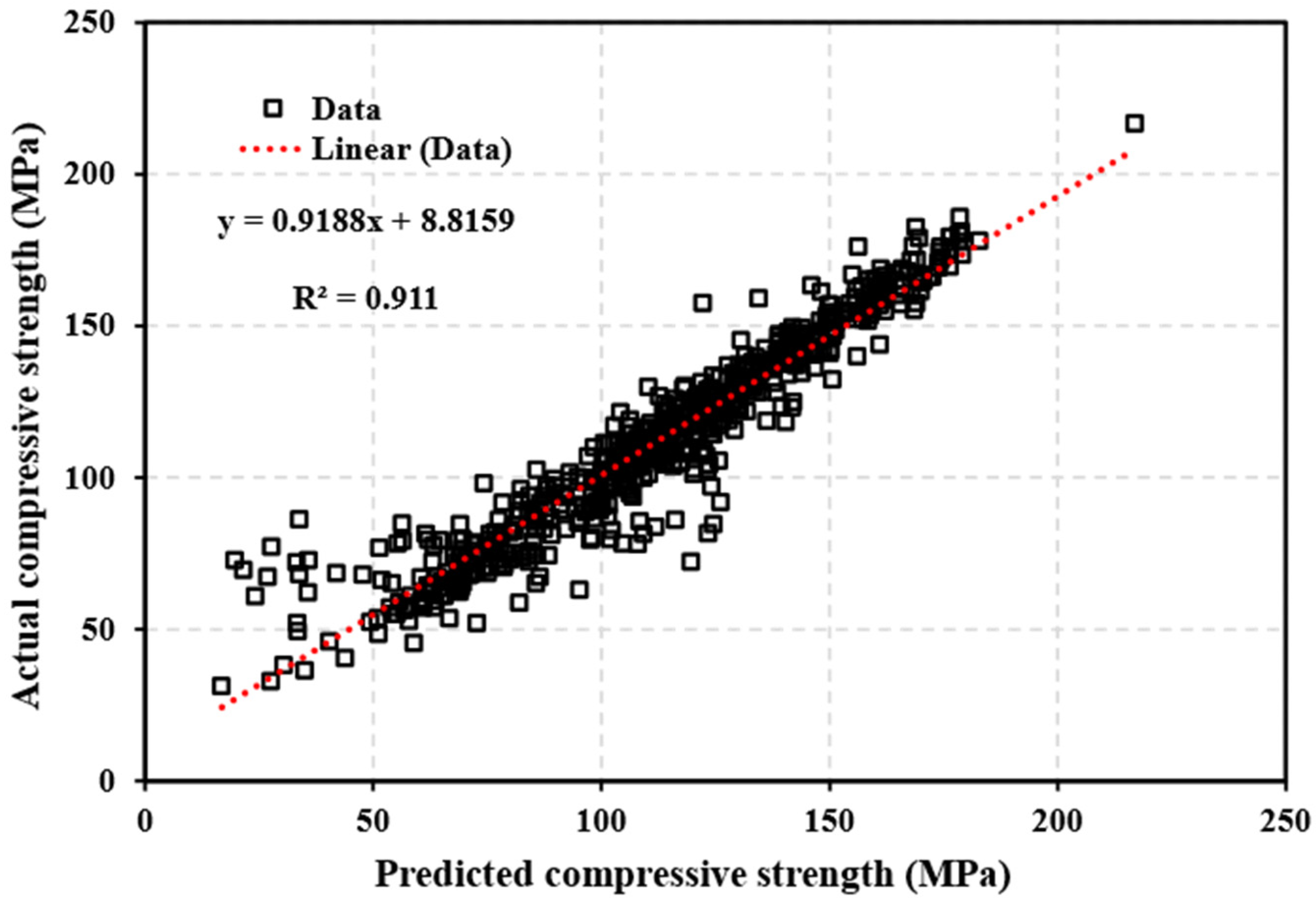
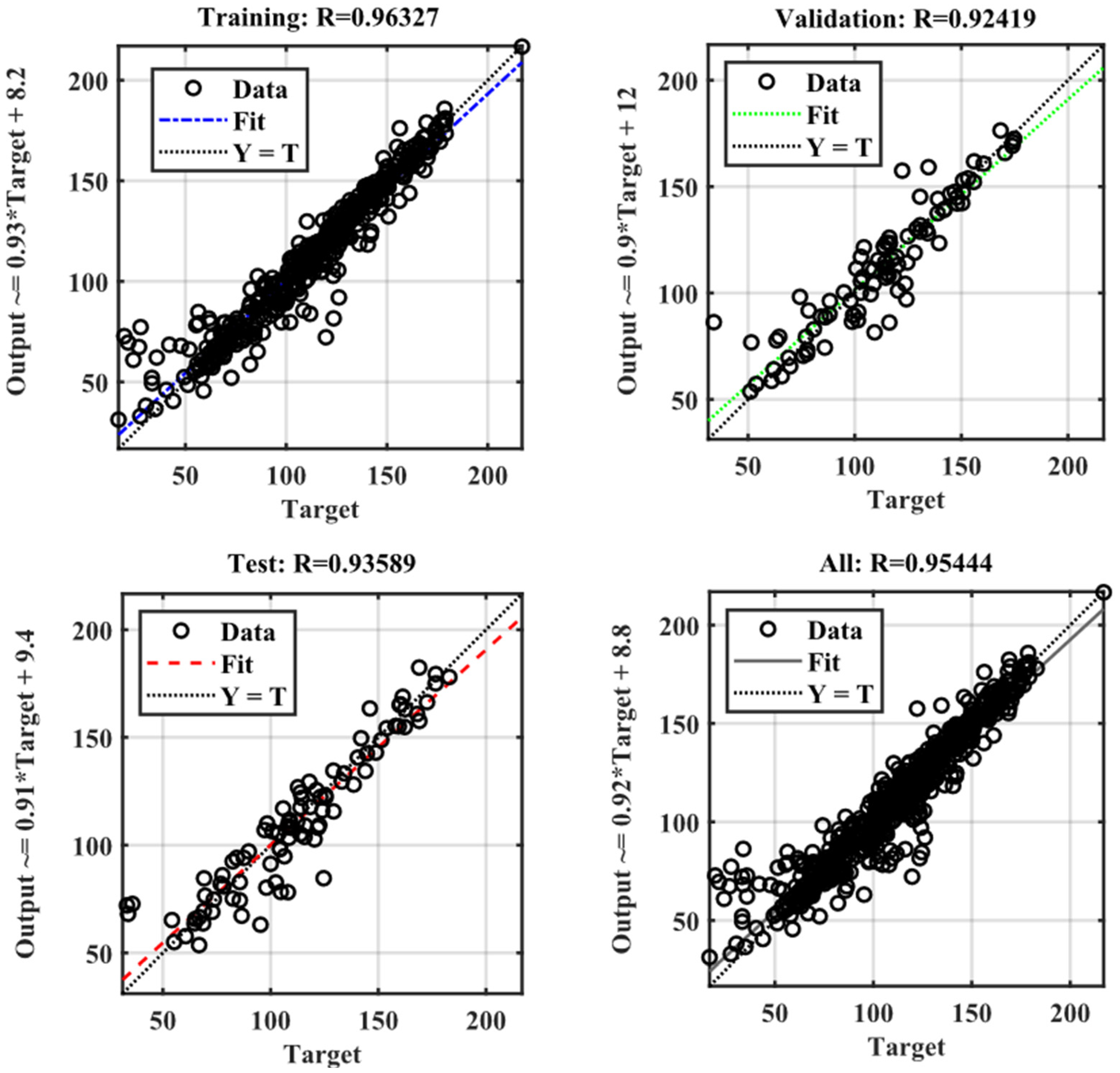
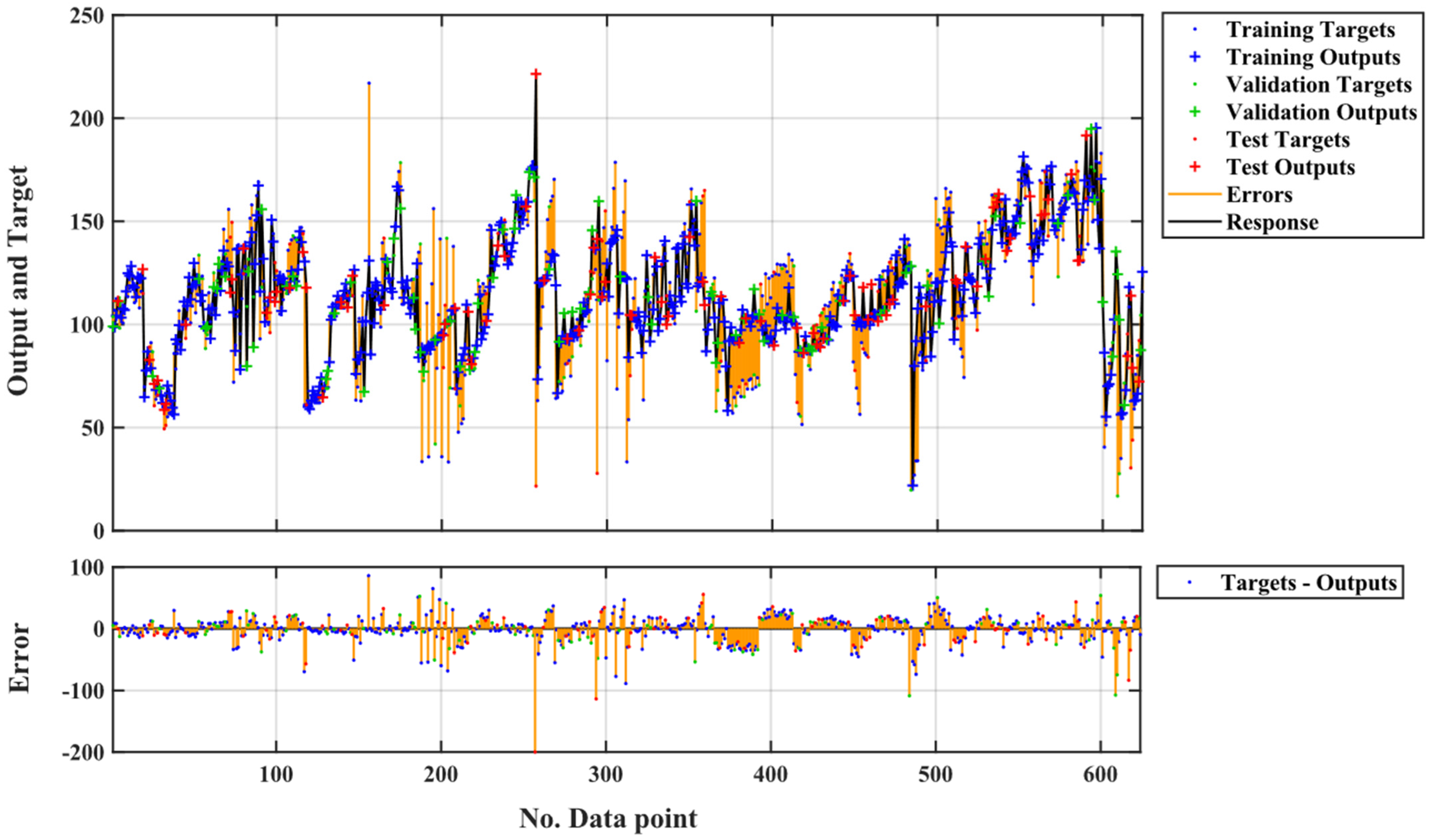
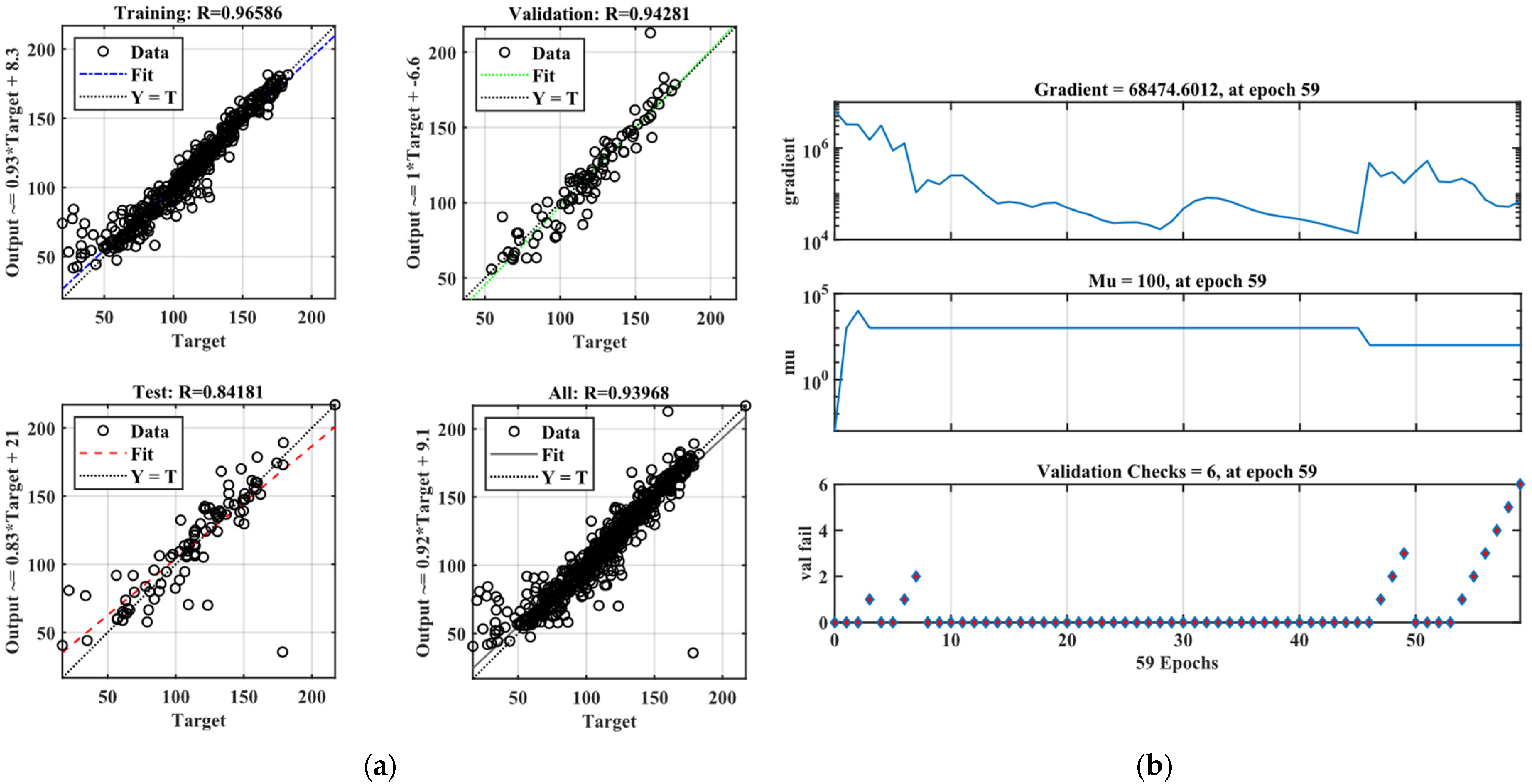
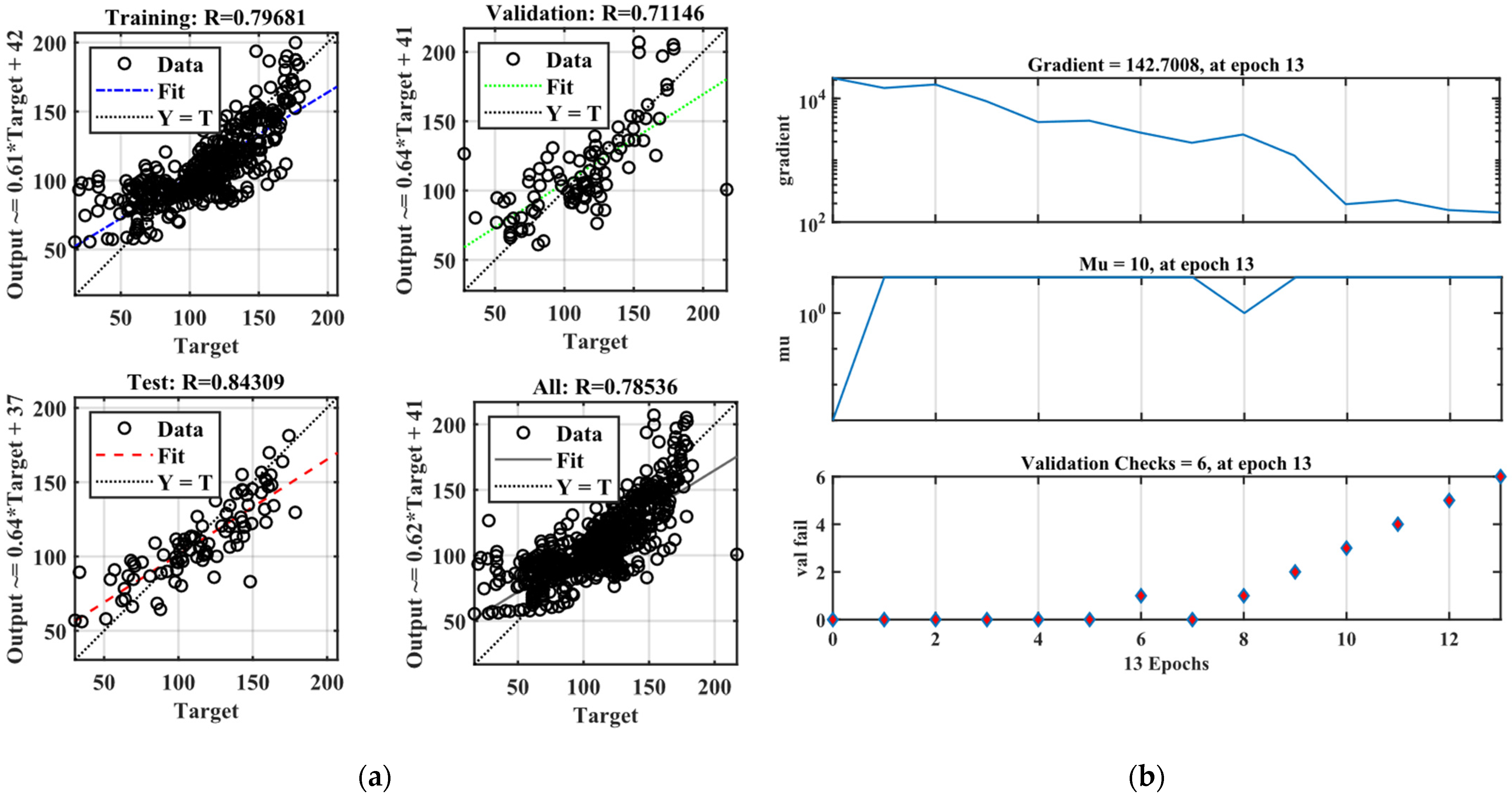

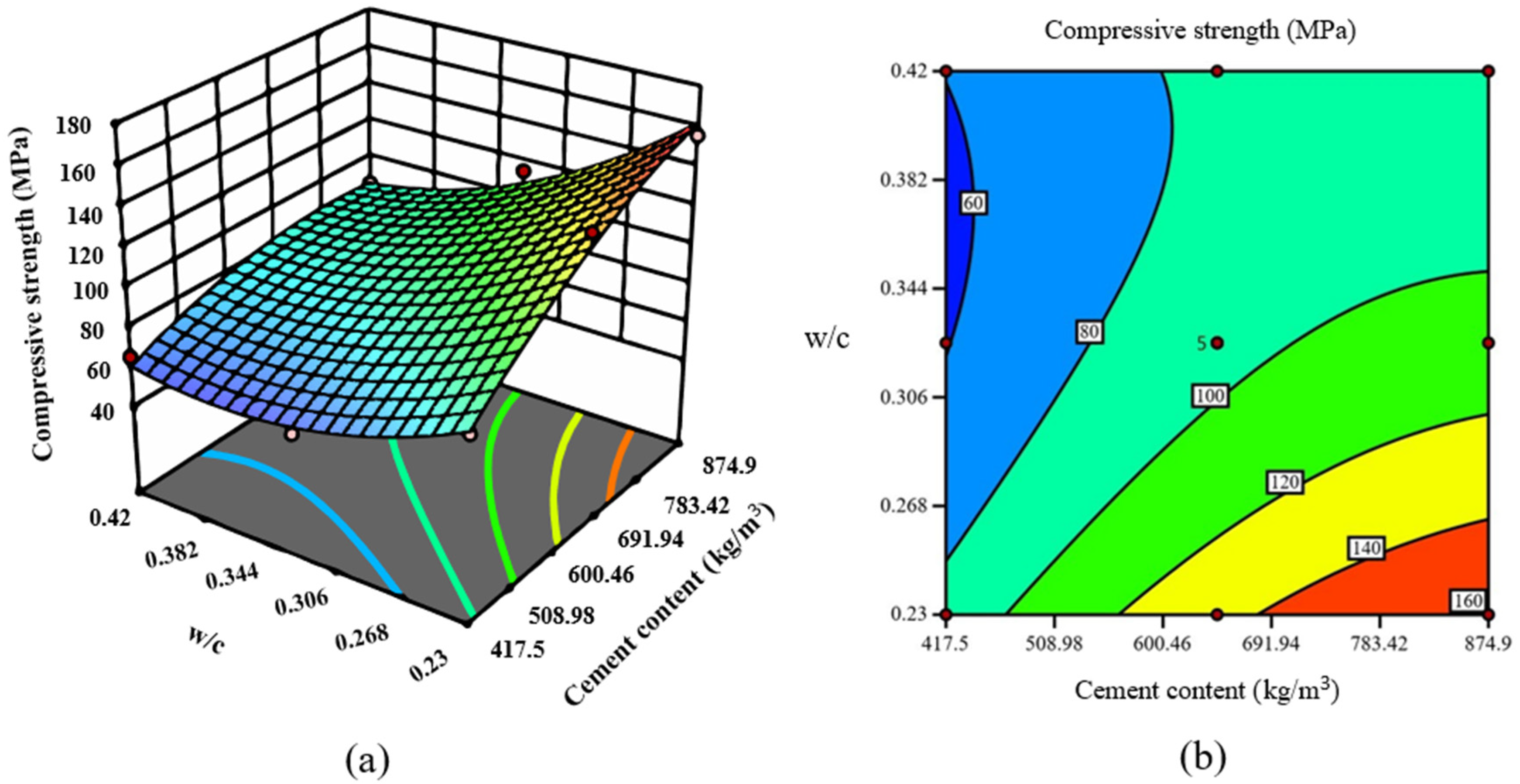
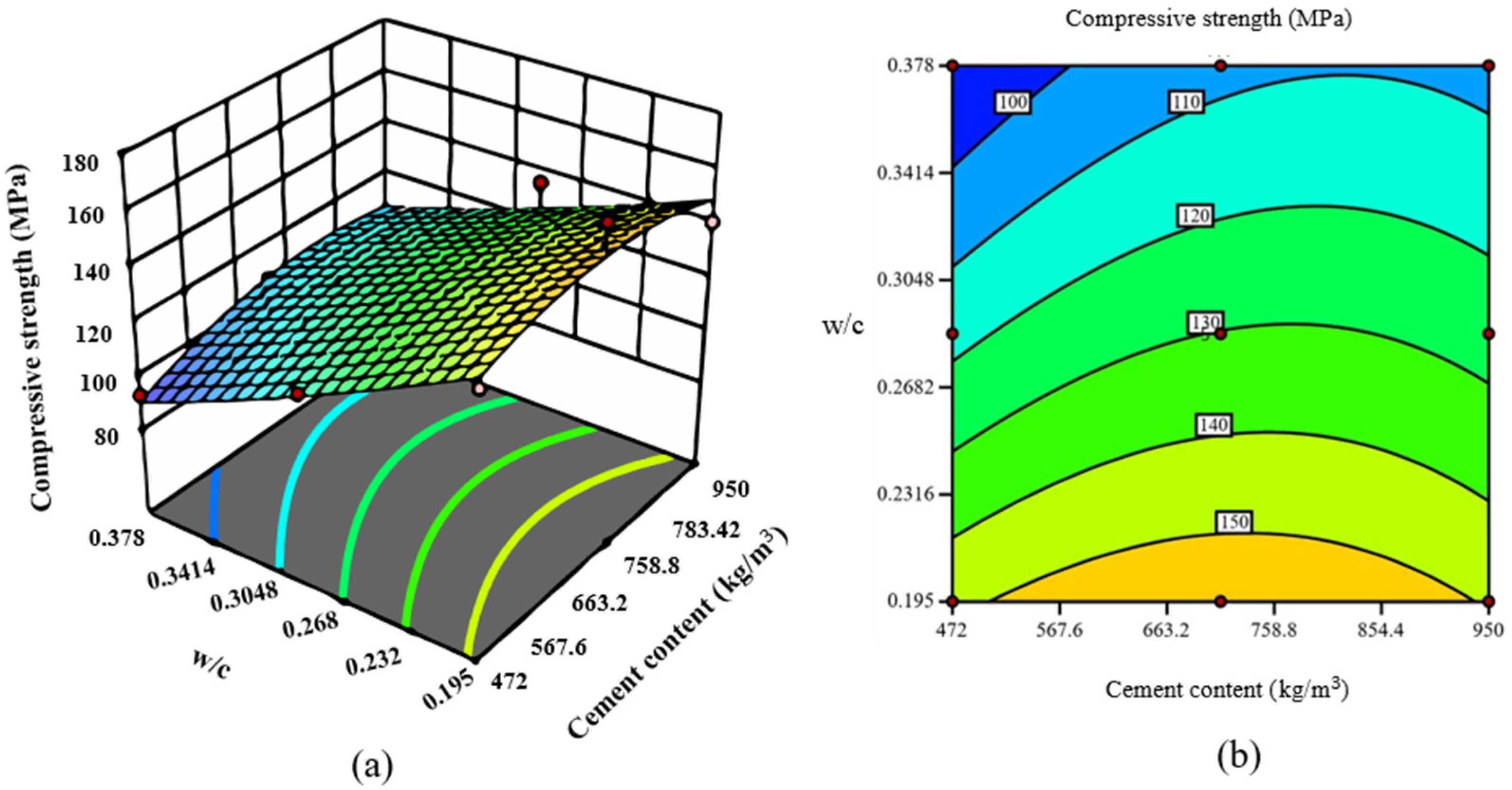

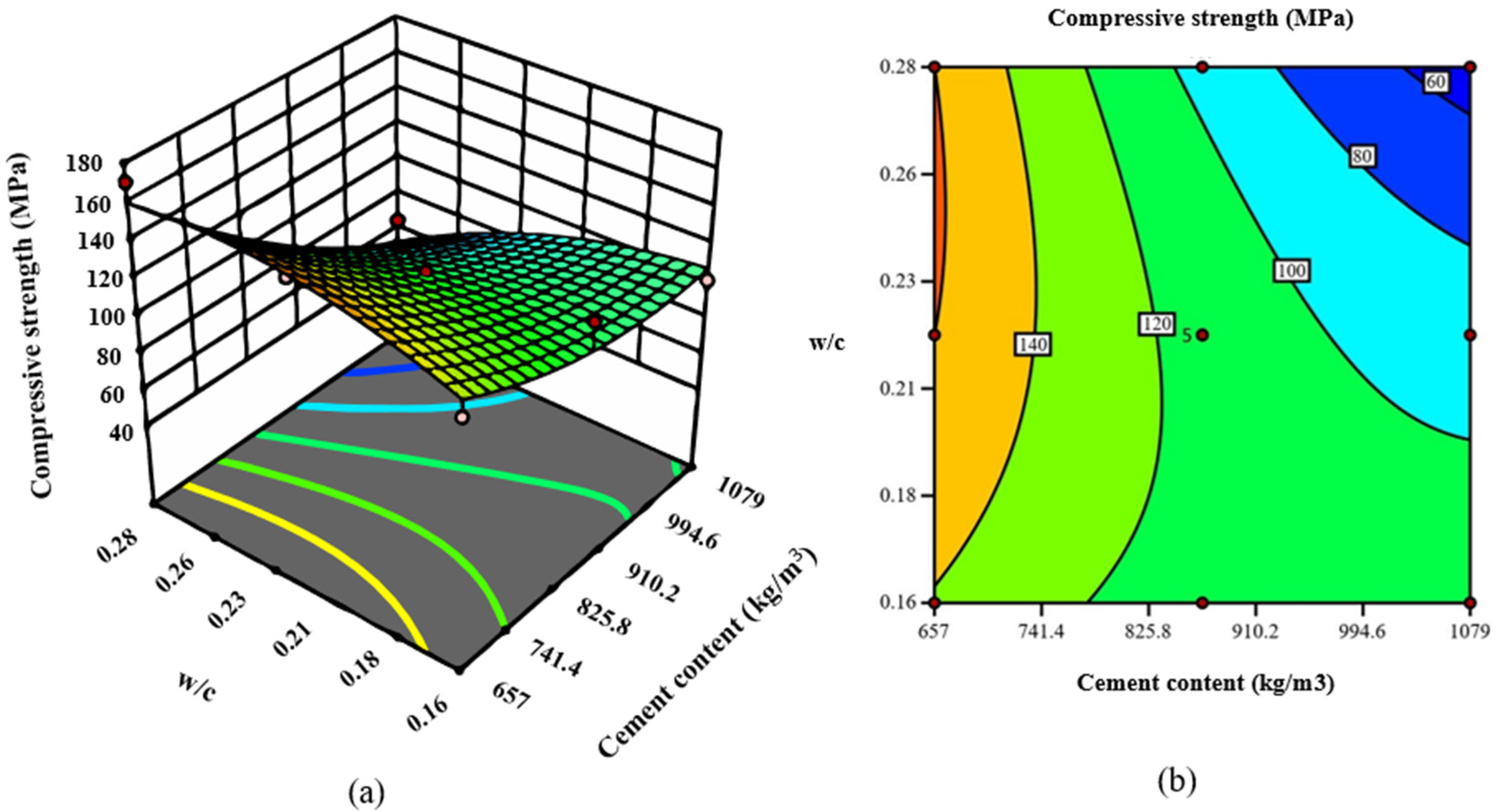
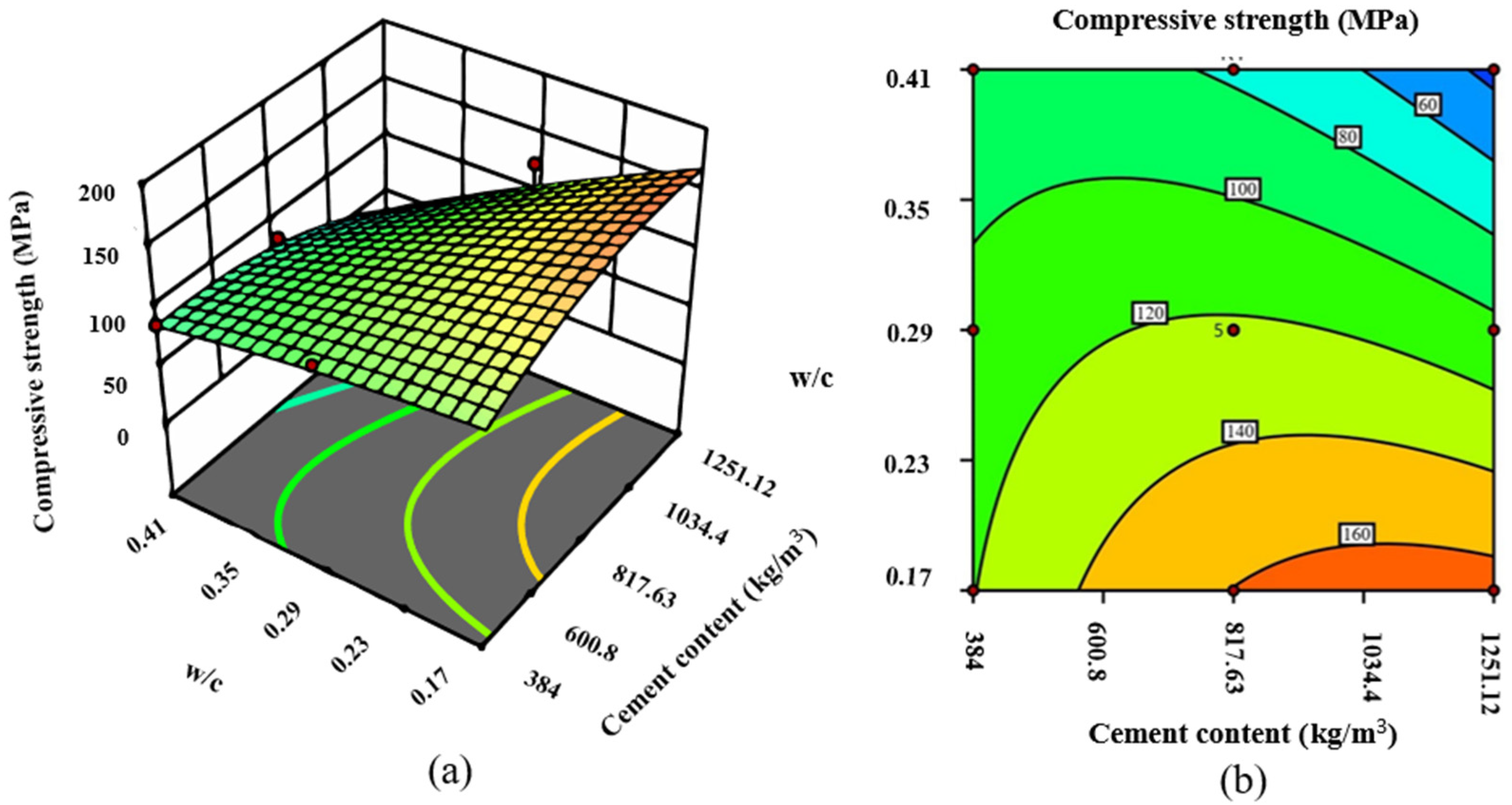


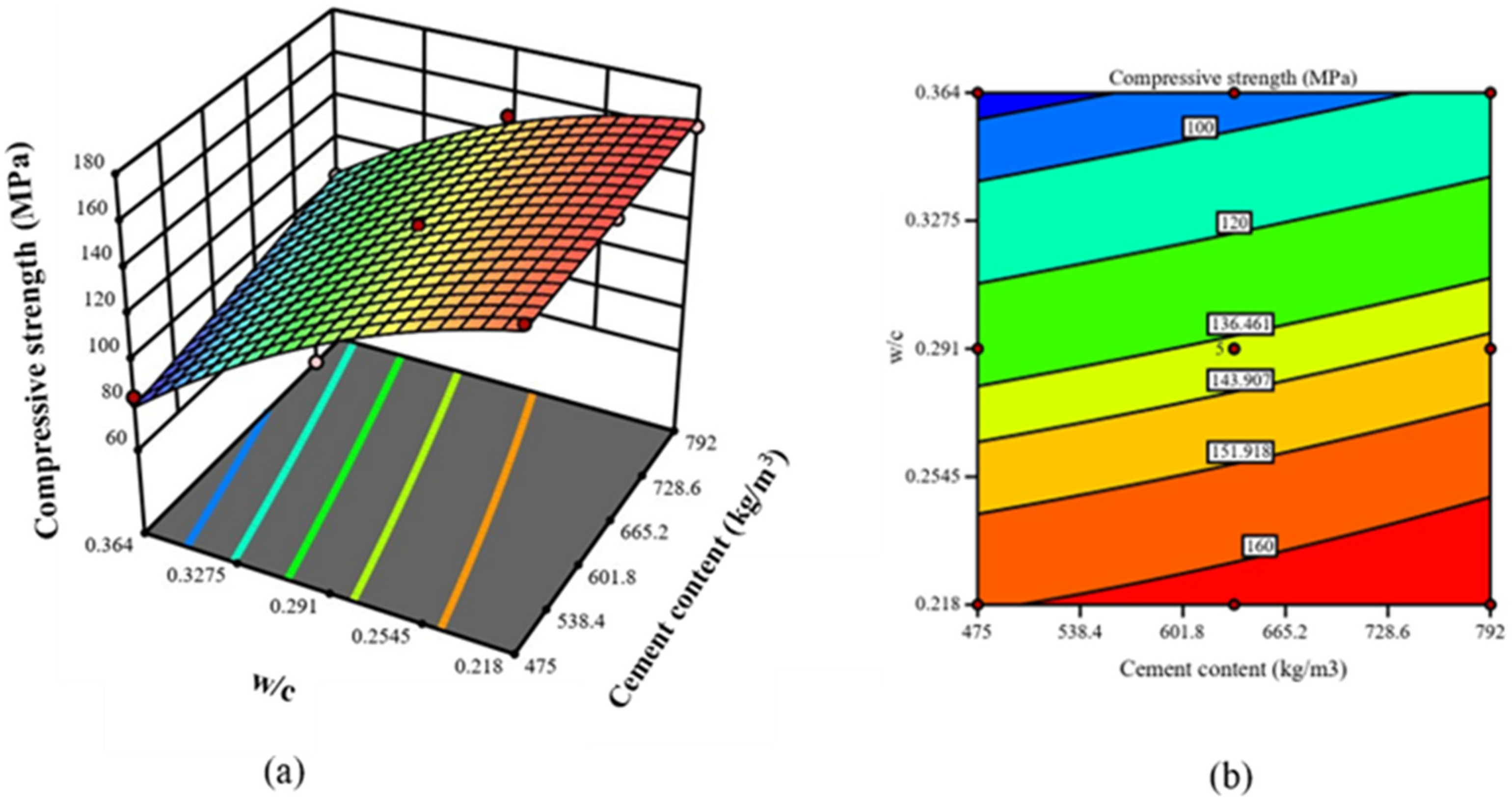


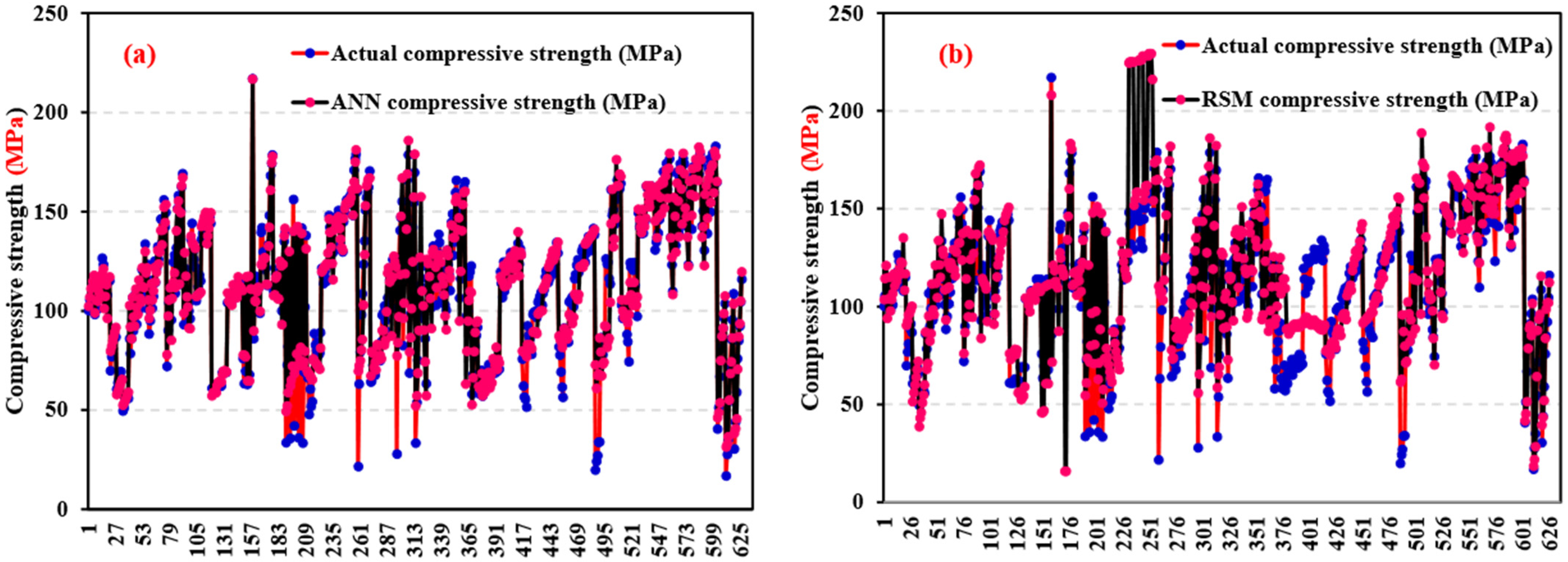
| Variable | Max | Min | Average |
|---|---|---|---|
| Cement content (kg/m3) | 1277.4 | 192 | 694.01 |
| Cement compressive strength | 52.5 | 42.5 | 48.66 |
| Cement type | 2 | 1 | 1.06 |
| Cement strength class | 1 | 0 | 0.59 |
| Fly-ash content (kg/m3) | 475 | 0 | 29.45 |
| Slag content (kg/m3) | 768 | 0 | 49.89 |
| Silica-fume content (kg/m3) | 291.3 | 0 | 105.19 |
| Nano-silica content (kg/m3) | 275 | 0 | 9.15 |
| Limestone powder content (kg/m3) | 1058.2 | 0 | 72.77 |
| Sand content (kg/m3) | 1503.4 | 407.8 | 989.37 |
| Coarse aggregates content (kg/m3) | 1298.61 | 0 | 213.48 |
| Maximum aggregate size (mm) | 20 | 0.1 | 4.87 |
| Quartz powder content (kg/m3) | 1249 | 0 | 32.47 |
| Water content (kg/m3) | 286 | 90 | 176.36 |
| Super-plasticizers content (kg/m3) | 52 | 5.1 | 27.13 |
| Polystyrene fiber content (%) | 2 | 0 | 0.04 |
| Polystyrene fiber diameter (mm) | 25 | 0 | 1.33 |
| Polystyrene fiber length (mm) | 18 | 0 | 0.70 |
| Steel fiber content (%) | 3 | 0 | 1.01 |
| Steel fiber diameter (mm) | 1 | 0 | 0.12 |
| Steel fiber length (mm) | 50 | 0 | 7.69 |
| Curing time (days) | 730 | 1 | 54.55 |
| Correlation Coefficient (R) | |||
| Epoch 42 | Epoch 59 | Epoch 13 | |
| Training | 0.96327 | 0.96586 | 0.79681 |
| Validation | 0.92419 | 0.94281 | 0.71146 |
| Testing | 0.93589 | 0.84181 | 0.84309 |
| all | 0.95444 | 0.93968 | 0.78536 |
| % decreasing in cumulative | -- | 1.58% | 16.9% |
| Mean Square Error (MSE) | |||
| Epoch 42 | Epoch 59 | Epoch 13 | |
| MSE | 140.6466 | 180.5462 | 300.1546 |
| Response | 1 | 2 | 3 | 4 | 5 | 6 | 7 | 8 | 9 | 10 |
|---|---|---|---|---|---|---|---|---|---|---|
| Max.C.S (MPa) | 123.4 | 159.56 | 156.53 | 212.45 | 129.15 | 167.66 | 132.72 | 127.63 | 165.28 | 132.72 |
| Min.C.S (MPa) | 102.86 | 88.73 | 91.2 | 71.74 | 53 | 37 | 62.72 | 85.09 | 79.86 | 62.72 |
| Cement Content (kg/m3) | |||||||
|---|---|---|---|---|---|---|---|
| 417.5 | 508.98 | 600.46 | 691.94 | 783.43 | 874.9 | ||
| w/c | 0.42 | −30.76% | −33.44% | −36.47% | −39.13% | −42.69% | −46.36% |
| 0.382 | −35.32% | −35.46% | −36.88% | −38.15% | −43.75% | −44.05% | |
| 0.344 | −34.96% | −33.52% | −33.61% | −34.26% | −36.52% | −38.58% | |
| 0.306 | −27.97% | −26.86% | −26.91% | −27.34% | −29.04% | −29.42% | |
| 0.268 | −10.63% | −15.49% | −14.24% | −15.64% | −17.43% | −18.09% | |
| 0.23 | -- | -- | -- | -- | -- | -- | |
Disclaimer/Publisher’s Note: The statements, opinions and data contained in all publications are solely those of the individual author(s) and contributor(s) and not of MDPI and/or the editor(s). MDPI and/or the editor(s) disclaim responsibility for any injury to people or property resulting from any ideas, methods, instructions or products referred to in the content. |
© 2024 by the authors. Licensee MDPI, Basel, Switzerland. This article is an open access article distributed under the terms and conditions of the Creative Commons Attribution (CC BY) license (https://creativecommons.org/licenses/by/4.0/).
Share and Cite
Li, T.; Jiang, P.; Qian, Y.; Yang, J.; AlAteah, A.H.; Alsubeai, A.; Alfares, A.M.; Sufian, M. Evaluation of Machine Learning and Traditional Methods for Estimating Compressive Strength of UHPC. Buildings 2024, 14, 2693. https://doi.org/10.3390/buildings14092693
Li T, Jiang P, Qian Y, Yang J, AlAteah AH, Alsubeai A, Alfares AM, Sufian M. Evaluation of Machine Learning and Traditional Methods for Estimating Compressive Strength of UHPC. Buildings. 2024; 14(9):2693. https://doi.org/10.3390/buildings14092693
Chicago/Turabian StyleLi, Tianlong, Pengxiao Jiang, Yunfeng Qian, Jianyu Yang, Ali H. AlAteah, Ali Alsubeai, Abdulgafor M. Alfares, and Muhammad Sufian. 2024. "Evaluation of Machine Learning and Traditional Methods for Estimating Compressive Strength of UHPC" Buildings 14, no. 9: 2693. https://doi.org/10.3390/buildings14092693
APA StyleLi, T., Jiang, P., Qian, Y., Yang, J., AlAteah, A. H., Alsubeai, A., Alfares, A. M., & Sufian, M. (2024). Evaluation of Machine Learning and Traditional Methods for Estimating Compressive Strength of UHPC. Buildings, 14(9), 2693. https://doi.org/10.3390/buildings14092693







